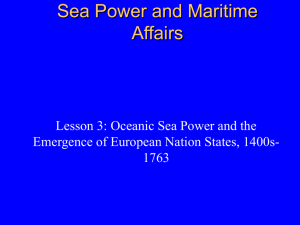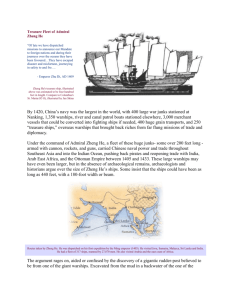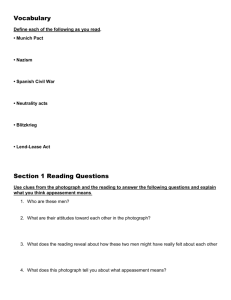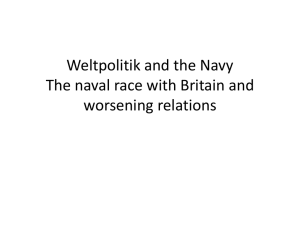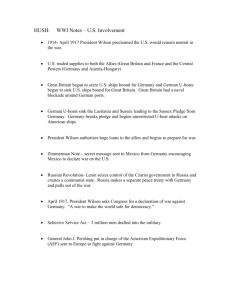Oceanic Seapower and the Emergence of Europe
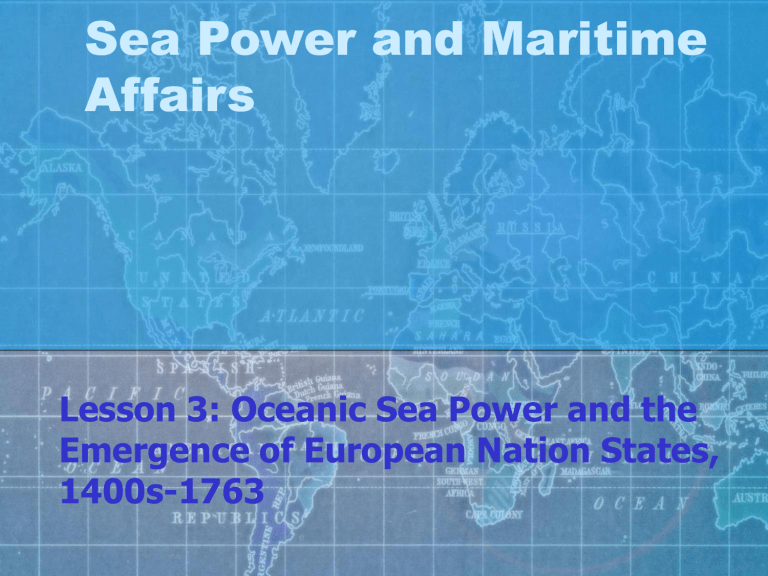
Sea Power and Maritime
Affairs
Lesson 3: Oceanic Sea Power and the
Emergence of European Nation States,
1400s-1763
Learning Objectives:
• The student will comprehend the importance of sea borne commerce and square-rigged oceangoing merchantmen and warships to Europe's emergence from the Middle Ages.
• The student will know the important voyages of discovery and the reasons they were organized.
• The student will comprehend the succession of great maritime powers in the 15th through the 17 th centuries (Portugal, Spain, the Netherlands,
Britain) and the reasons for the rise of each and the decline of all except Britain.
Learning Objectives (cont.):
• The student will comprehend the causes and significance of the Grand Armada (1586-1588) to include the transition from galley warfare to that between sailing ships mounting cannon in broadsides.
• The student will comprehend the important historical events and strategic goals of France and Britain in their confrontations from the late 1600s to 1763.
• The student will know the major effects of events in Anglo-
French relations on their colonial possessions in North
America and around the world from the late 1600s to 1763.
What Were Those Themes Again?
• The Navy as an Instrument of Foreign
Policy
• Interaction between Congress and the
Navy
• Interservice Relations
• Technology
• Leadership
• Strategy and Tactics
• Evolution of Naval Doctrine
What Were Those Themes Again?
• The Navy as an Instrument of Foreign
Policy
• Interaction between Congress and the
Navy
• Interservice Relations
• Technology
• Leadership
• Strategy and Tactics
• Evolution of Naval Doctrine
Review From Last Class:
• “Communications dominate war”
• What was the primary naval vessel from
2500 B.C. to 1571?
• Who were some of the early sea powers in the Mediterranean?
• What were some of the major naval actions during the ancient period?
Age of Sail
The 16th Century through the 19th
Century.
Why did Western Europe emerge at this time?
• There were several reasons that Western
Europe became a major player in international trade and commerce:
• Dissimilar climate, geography, and peoples
• Navigable rivers and surrounding coastal waters
• Growth of middle class of artisans, merchants, and tradesmen.
• Development of systems of exchange, banking, investment, and insurance.
• Rise in disposable income created demands for foods and goods from other continents.
Sailing Ships
• Galleys useless on Atlantic Ocean due to high sea states and poor weather.
• Merchant ships developed into caravels and then galleons .
• Forecastles and aftercastles developed.
• Initially grappling hooks are used for boarding enemy ships, then cannon are used to attack at longer range.
• Improvements in navigation.
• Magnetic compass and “dead reckoning” or DR.
• Angle of stars above the horizon provided latitude.
• Allowed longer voyages away from land.
Difficulties of Navigation in the 15 th – 18 th Centuries:
• What is Dead Reckoning
How did mariners find direction?
How did they measure speed?
• Finding Latitude:
Required a steady platform and a knowledge of mathematics
Reflecting quadrant – 1731
Sextant -- 1757
• Finding Longitude:
Utterly impossible for the early mariner
The chronograph was invented in 1761
Early Navigational Equipment:
A Typical Caravel:
The Age of Exploration:
Portugal:
• Prince Henry “The Navigator” – began exploration of Africa
• Bartholomew Diaz – rounded Cape of Good Hope (1486) searching for a maritime route to the Orient
• Vasco de Gama – sea route to India (1497) – conflict with Arabs
• Cabral – voyaged to Brazil
Spain:
• Columbus – discovered the Americas (1492) – named for Amerigo Vespucci
• Magellan – circumnavigated the Globe (1519-1522)
• The Conquistadors:
Balboa – Panama (1513)
Ponce de Leon – Florida (1513)
Cortez – Mexico (1520) – destroys Aztec Empire
Pizarro – Peru (1532_ -- destroys Inca Empire
Prince
Henry of
Portugal
“The Navigator”
Christopher
Columbus
Admiral of the
Ocean Seas
Spain vs. England (1567-1604):
• Spain = Superpower
• Conflicts with France for N Europe, Turkey for the
Med.
• Spanish Netherlands revolts and serves as distraction from quest for Sea Control.
• Spanish king, Philip II sends large army to
Netherlands, 1566.
• England’s options limited, creates “Cold War”
King Phillip II & Queen Elizabeth I:
The Spanish Armada, 1567-1585
1588 - The Spanish Armada:
English Fleet
•34 large warships
•163 smaller vessels
Spanish Armada
•62 large warships
•68 smaller vessels
•2,000 guns
•16,000 men
Advantage:
•Range/Accuracy of
Weapons
•Maneuverability
•Leadership
•1,100 guns
•27,000 men
Advantage:
•Pounds per Gun
- Total weight of broadside.
•Personnel
The English Upper Hand:
• Spanish: Duke of Medina Sidonia
• English: Charles Howard of Effingham, Lord
Admiral of England
• Tactics
• “Weather Gage” effectively utilized by British.
•
Held upwind position.
•
•
Now able to “off-fight” with longer range guns.
• Previously ships had to make physical contact to engage.
Maneuverability now more important.
• English had superior seamanship skills.
Route of the
Spanish Armada:
Defeat of the Spanish Armada:
• Spanish defeated in English Channel.
• Many Spanish ships wrecked in North Sea storm.
• Spain and its empire begin a long period of decline.
• England begins to establish overseas colonies
- America.
• English Lesson:
• Decisions at sea were henceforth to be reached not by hand-to-hand combat but with naval guns
Rise of English Sea Power:
• Mid-1500’s - England begins to develop a standing fighting fleet under Henry VIII.
• Sea power vital to English (British) victory in a series of conflicts with other European powers:
• Spain (1567-1604)
• Holland (1652-1674)
• France (1689-1815)
• English Navy is of primary importance to the defense of
England and its growing overseas empire.
• Designated Royal Navy in 1660 by King Charles II.
• England (including Wales) and Scotland form United
Kingdom of Great Britain in 1707 and add Ireland in
1801.
• British Empire continues to grow overseas.
• Naval tactics developed and formalized.
Men of War:
• Forecastles and Aftercastles eliminated.
• Increased speed and stability.
• Multiple decks with gunports.
• More guns added.
• Full-rigging.
• Faster speeds.
• Many sailors.
• Needed to man sails and guns.
And now for todays…
POP QUIZ!
ARGH! Man the Poop Deck!
True or False:
The poop deck was used for defecating?
FALSE!
In naval architecture , a poop deck is a deck that constitutes the roof of a poop cabin built in the aft (rear) part of the superstructure of a ship . The name originates from the Latin crew.
puppis , or the elevated stern deck. In sailing ships, with the steerage at the stern, an elevated position was ideal for both navigation and observation of the
An urban legend suggests that the name comes from the practice of sailors going to the poop deck to poop , i.e. defecate.
[1] This is not correct, since facilities for this purpose were located at the bow (forward end) of the ship. (See head ). Only the captain had his private toilet near his quarters, below the poop deck.
Men of War:
Propulsion:
Armament:
Formation:
Sail
Guns (Broadside)
Line-Ahead
5
6
3
4
Rate Guns
1
2
> 100
80-100
60-802
50-601
30-441
20-281
?
2
Decks
3
3
Notes
Ships of the Line (Flag)
Ships of the Line (Flag)
Ships of the Line (Private)
Cruisers (Flag)
Cruisers (Frigates)
Cruisers (Sloops, Brigs &
Schooners)
Man of War-
Ship of the Line
Anglo-Dutch Wars
(1652-1674):
• Series of three naval wars. (1652-54, 1665-67,
1672-74)
• Dutch United Provinces gain maritime trade monopolies.
• Use dominant sea power to advantage after independence from Spain in 1609.
• Challenged by Cromwell’s England: Builds the
Navy
• Navigation Act, 1651
Anglo-Dutch Wars
(1652-1674)
• Dutch weaknesses
• Dependent upon sea for livelihood
• Had to fortify land frontier
• Did not have ships of the line
• Not tactically savvy (vis-à-vis British)
Anglo-Dutch Wars
(1652-1674)
• English naval tactics developed: “Fighting
Instructions”
•
•
“Line ahead” formations become standard.
• Provides ability to fire “broadsides” at enemy fleet.
Royal Navy debates between Formal and Melee schools.
• Dutch loses possessions in North America.
•
Hudson Valley and New Amsterdam (New York City)
• Fatal weaknesses: Dependent on sea, threats from other continental powers, configured for shallow water.
Line Ahead Formations:
Wind
Weather Gage
Lee Gage
Fleet Advantages
• Weather Gage
• Held by the upwind fleet.
• Ability to determine the time and range of engagement of the enemy fleet.
• Lee Gage
• Held by the downwind fleet.
• Ability to determine the time of disengagement from the enemy fleet.
Ships of the Line:
• Only heavily gunned ships able to remain in line ahead formation during battle.
• Greater than 80 guns required.
• Smaller ships (cruisers) detached for patrol, reconnaissance, blockade, and attacks on enemy merchant ships (commerce raiding).
• Fleet with better gunnery skills can gain the advantage.
• Importance of training sailors to fire guns rapidly and accurately.
Continued Development of Formal Tactics:
Wind
Formal Tactics
Wind
Formal Tactics
Wind
Melee Tactics Theory”
• To gain the advantage, one needs to concentrate firepower against the enemy fleet.
• Allows a superior weight of broadside.
• A conterminous line-ahead formation does not allow firepower to be massed.
• Must maneuver the fleet to gain the advantage in firepower.
• Massing
• Doubling
• Breaking the Line
Melee Tactics:
Wind
Melee Tactics
Wind
“Massing”
Melee Tactics
Wind
Melee Tactics
Wind
“Doubling”
Melee Tactics
Wind
Melee Tactics
Wind
“Breaking the Line”
Anglo-French Conflicts (1689-1775):
• Great Britain fears France's threat to become militarily dominant in Europe.
• Continental element:
• France Army 5-to1 to the British
• Britain monetarily and militarily subsidies her continental allies
• Maritime element:
• Britain prospered through commerce across the Atlantic
• Royal Navy “shows the flag” from warships
• Britain gaining timber and Naval supplies from the Baltic.
• Britain maintained a fleet twice the size of France
• Permanent Fighting Instructions adopted by Royal
Navy.
• Results of sea battles support the use of formal tactics.
Permanent Fighting Instructions:
Wind
Van Center Rear
Tactics:
• French Navy - Defensive
• Desired to hold the lee gage.
• Able to retire in order to save ships.
• Unable to devote resources to Navy due to wars in
Europe.
• Fired on the “up roll” to target rigging (masts and sails).
• Reduce British ability to maneuver into attack position.
• Few British casualties.
• Royal Navy - Offensive
• Desired to hold the weather gage.
• Advantage to the attacking fleet.
• Fired on the “down roll” into the enemy hulls
• Splinters and debris killed and maimed French gun crews.
• High numbers of French casualties.
Wind
British Fleet
French Fleet
Anglo-French Conflicts
(1689-1775):
War of English Succession (1689-1697):
• English goal: Contain French aggression; maintain balance of power on continent of Europe.
• Battle of Beachy Head (1690), Battle of Barfleur (1692)
• Louis XIV lost the war; France abandoned its continental conquests; acknowledged William of Orange as King of
England.
War of Spanish Succession (1703-1713):
• Britain acquires possessions of France and her allies (e.g.,
Spain, Gibraltar)
• Battle of Malaga: Tactically indecisive, but French "flinched under bombardment" and retreated to port.
• Great Britain was now leader in maritime commerce and clearly the "Mistress of the Seas."
Seven Years’ War
(1756-1763):
Battle for Minorca 20 May 1756:
• April 1756 French amphibious landing on
Minorca
• British attempt to send reinforcements
• Formal Fighting Instructions prevented maneuvers
• Refocused interest on more flexible tactics
Seven Years’ War
(1756-1763):
Significance:
• Geopolitical: Genuine world war; fought in German states,
Mediterranean, Canada, West Indies, India, Africa, and
Philippines.
• Strategic: Classic example of conflict between land power
(France) and sea power (England).
Great Britain Key to victory -- “Pitt’s Plan” of William Pitt the Elder:
•
•
“Hitting” - Attack overseas colonies of France and Spain.
“Holding” - French battle fleet through blockade of ports.
• Support continental allies: Frederick the Great of
Prussia.
“Pitt’s Plan”:
• Subsidize one or more allies on Continent
• Use own fleet to
• raid enemy coasts, thereby holding enemy troops away from allies
• blockade enemy and destroy his fleet
• convoy and support own troops in seizing enemy’s overseas colonies and associated seaborne trade
Seven Years’ War
(1756-1763)
• French counter-strategy
• Raid British maritime commerce
• Defend French Colonies
• Try to invade England
• Known as “French and Indian War” in America.
• British Siege of Quebec - 1759.
•
• Wolfe defeats Montcalm on the Plains of Abraham.
British defeat French at Battle of Quiberon Bay -
1759.
• Peace of Paris - 1763
• Great Britain obtains Canada, U.S. East of Mississippi
River to Appalachian Mts., Florida, and much of
India.
Siege of Quebec:
Battle of Quiberon Bay - 1759
• Royal Navy establishes absolute control of the sea.
• French plan to invade Great Britain is thwarted.
Ongoing debate????
• Lessons from the Seven Years’ War
• Potter, Nimitz, Mahan will conclude:
• Naval power, or sea power, was "pervasive and inexorable."
• Naval predominance was decisive in a world war.
• Paul Kennedy will conclude:
• Sea power was only one component of British strategy during the period.
• A "continental" element was always present in the
British considerations.
Learning Objectives
• The student will comprehend the importance of sea borne commerce and square-rigged oceangoing merchantmen and warships to Europe's emergence from the Middle Ages.
• The student will know the important voyages of discovery and the reasons they were organized.
• The student will comprehend the succession of great maritime powers in the 15th through the 17 th centuries (Portugal, Spain, the Netherlands,
Britain) and the reasons for the rise of each and the decline of all except Britain.
Learning Objectives
• The student will comprehend the causes and significance of the Grand Armada (1586-1588) to include the transition from galley warfare to that between sailing ships mounting cannon in broadsides.
• The student will comprehend the important historical events and strategic goals of France and
Britain in their confrontations from the late 1600s to 1763.
Learning Objectives
• The student will know the major effects of events in Anglo-French relations on their colonial possessions in North America and around the world from the late 1600s to
1763.
ANY QUESTIONS?
Next Lesson: The American Revolution
For Next Class:
• Potter Chapters 1 & 2 (review of last two lessons)
• Hagan Chapter 1 / Atlas p. 3-20 (preparation for next lecture)
• Quiz #1 will cover the information presented in Lessons
1, 2, 3:
• Sea Power in the Ancient Mediterranean World, from the Phoenicians to the Battle of Lepanto (1571)
• Oceanic Sea Power and the Emergence of European
Nation States, 1400s-1763
• Study with the Learning Objectives in mind
• Format: multiple choice, fill-in, timeline, short answer
• Come see me if you have any questions or concerns!!!
• Read and understand the speaker notes!
